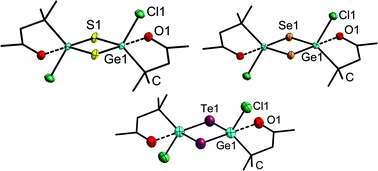Dinuclear organogermanium chalcogenide complexes as intermediates towards functionalized clusters†
Abstract
Reactions of R1GeCl3 (R1 = CMe2CH2COMe) with (Me3Si)2E (E = S, Se, Te) yield three new organogermanium chalcogenide complexes [(R1GeCl)2S2] (1), [(R1GeCl)2Se2] (2), and [(R1GeCl)2Te2] (3) with functionalized ligands R1 = CMe2CH2COMe. NMR titration experiments clearly demonstrate that these dimeric complexes are intermediates in the formation of the well-known sesquichalcogenide clusters [(R1Ge)4E6]. In striking contrast to related tin compounds that were recently reported, the mono-bridged complexes of the type “[(R1GeCl2)2E]” and defect-heterocubane-type clusters “[(R1Ge)3E4Cl]” do not form on the NMR time scale for E = S or Te, and only in traces for E = Se.

- This article is part of the themed collection: Inorganic chemistry of the p-block elements


 Please wait while we load your content...
Please wait while we load your content...